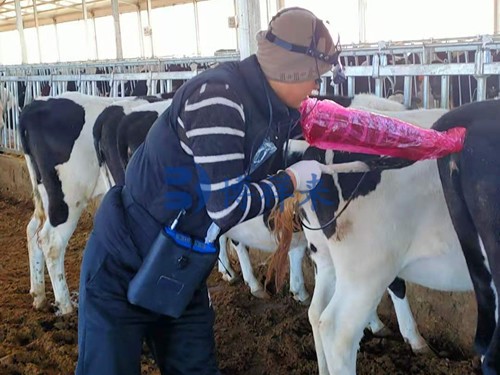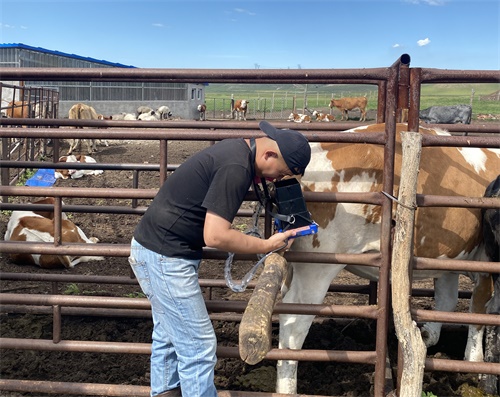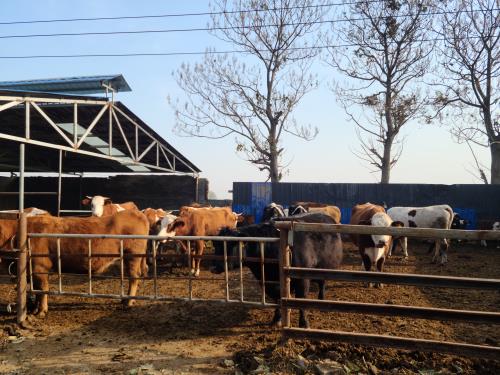On-farm animal care is being transformed by handheld ultrasound devices that bring real-time imaging directly to livestock. These compact scanners use high-frequency sound waves to create images of internal structures without any incisions. Unlike traditional bulky equipment, modern handheld units connect to tablets or smartphones and can operate in barns, pastures, or clinics. As one review notes, ultrasound use in veterinary medicine “continues to expand worldwide,” and new handheld systems enable timely, point-of-care diagnosis. Farmers and veterinarians worldwide now rely on portable ultrasound as an essential tool for on-site screening of herd health and growth.

Handheld ultrasound devices allow producers to “see inside the animal—safely, instantly, and with remarkable accuracy”. By scanning organs, fat deposits, and muscles on the spot, users can make informed decisions about breeding, nutrition, or treatment without waiting for lab tests or shipping animals to clinics. This capability has led to a data-driven approach in animal agriculture: instead of guesswork, farmers get immediate visual feedback. For example, modern livestock ultrasound scanners are designed to be rugged and waterproof for field use. They produce high-definition, real-time images (often B-mode cross-sections) that veterinarians and trained farmers can interpret on location. In effect, handheld ultrasound democratizes diagnostic imaging, providing real-time insights that improve animal welfare and farm profitability.
Advances in Portable Ultrasound Technology
Recent years have seen rapid innovation in ultrasound hardware and software. Key technical improvements include:
Compact Probes and Adaptability: Modern probes are built for specific tasks and species – for instance, rectal probes for cattle pregnancy checks or convex abdominal probes for pigs and sheep. They are ergonomic, durable, and often waterproof, so they withstand barnyard conditions. Some probes even have wearable designs (clip-on or strap) for hands-free scanning during herd work.
High-Resolution Imaging: Thanks to digital signal processing and advanced transducers, portable ultrasounds now deliver image clarity comparable to full-size machines. Adjustable frequency ranges and preset modes let users optimize image quality for different depths and species. New transducer technologies (like capacitive micromachined ultrasound transducers) broaden bandwidth and improve resolution.
Wireless Connectivity: Many handheld units interface with smartphones or tablets via USB, Wi-Fi, or Bluetooth. This allows images and data to be displayed on a larger screen or saved in the cloud. Users can share scans in real time with remote experts or incorporate them into digital herd records for traceability.
Battery Life and Portability: High-capacity lithium batteries power portable scanners for 4–8 hours of continuous use. The devices themselves are lightweight – some weighing just a few hundred grams – making them easy to carry across large farms. The portability means veterinarians can perform scans anywhere (milking parlor, piggery, equine barn) without lugging heavy carts.
AI and Software Assistance: The newest handheld systems often include smart features. Artificial intelligence can automatically identify structures, estimate gestational age, or highlight abnormalities. Touch-screen apps guide the user through scan protocols and even suggest next steps. Such “smart” enhancements help less-experienced operators get reliable results faster.
Together, these features make handheld devices true point-of-care ultrasound (POCUS) systems. By design, they trade some of the bells and whistles of high-end machines for greater versatility and portability. But they still provide the essential functionality: real-time, quantitative imaging at a fraction of the cost and size of a full lab setup.
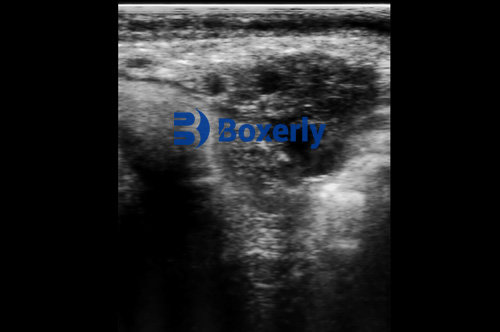
Key Benefits of On-Site Ultrasound Screening
Veterinary and agricultural professionals have embraced handheld ultrasound for several practical advantages:
Immediate, On-the-Spot Diagnosis: As Obi Veterinary Education notes, handheld units allow “quick and accurate diagnostics right at the point of care,” which dramatically reduces the time needed to confirm conditions and begin treatment. For example, instead of waiting days for lab results, a farmer can instantly check for pregnancy or an organ issue during a routine visit.
Portability and Convenience: These devices are “lightweight and easy to carry,” making them ideal for use on the farm, at livestock auctions, or in remote pastures. Vets no longer need to transport large animals to a clinic for imaging – examinations can happen right in the field, saving time and stress.
Non-Invasive and Stress-Free: Ultrasound is completely non-invasive (no needles or sedation needed for most scans). This means animals experience minimal discomfort. On-site scanning also avoids the stress and risk of shipping animals to vet hospitals. Studies show that doing diagnostics in familiar surroundings improves animal welfare.
Cost-Effectiveness: Compared to traditional ultrasound machines, handheld units are generally more affordable. Over time, having an in-house scanner can “lower veterinary costs” by reducing reliance on outside services. Many farmers train their own staff to operate the equipment, further cutting expenses.
Versatility: A single handheld device can handle a wide range of examinations. With different preset modes and probes, it can scan abdominal organs, heart, reproductive tract, or even tendons and joints. This multi-purpose use makes it valuable across many kinds of animals (cattle, swine, sheep, goats, horses, etc.) and multiple stages of production.
Data-Driven Management: Because images are digital, they can be saved, measured, and analyzed over time. Farmers gain quantitative data to guide decisions – for example, knowing exact backfat thickness or eye muscle area. In one case, integrated pig farms using ultrasound data reported up to 15% feed cost savings during gestation by precisely adjusting rations. Better records also assist with genetics and meeting traceability standards.
These benefits translate into real improvements on farms. Early and accurate detection of pregnancies and diseases leads to better herd health, and decisions about feeding or culling are based on solid evidence rather than guesswork. Over time, this can boost productivity and profitability while enhancing animal welfare. For example, pregnancy scans at just 25–30 days post-breeding allow quick rebreeding of empty cows or sows, and identifying sick or compromised animals early can prevent losses.
Key Applications in Livestock Screening
Handheld ultrasound is used for a variety of on-site screening tasks across species:
Pregnancy Diagnosis: This is one of the most common uses. Farms worldwide use ultrasound to confirm pregnancy in cows, sows, ewes, and does much earlier than traditional methods. Early detection (around 4 weeks in cattle, 3 weeks in pigs) saves months of wasted feeding on non-pregnant animals. It also identifies twin or abnormal pregnancies. For instance, sheep and goat farmers in Australia routinely use ultrasound not only to detect pregnancy, but also to age fetuses and determine sex, which helps in early marketing plans and has significantly improved lambing rates.
Reproductive Tract Health: Ultrasound lets vets evaluate the ovaries and uterus directly. Practitioners can spot ovarian cysts, infections, or delayed ovulation that might be missed by palpation. Regular scanning has become standard in some countries: in Netherlands dairy herds, weekly ovarian monitoring by ultrasound allows precise hormonal treatments and higher conception rates. In swine production, ultrasound checks uterine tone and fluid to catch postpartum problems like retained placenta.
Growth and Body Composition: Farmers use ultrasound to measure muscle and fat, which guides feeding and finishing decisions. Measuring the loin (eye muscle) area and subcutaneous fat depth on live animals gives an accurate picture of growth performance. For example, producers in Canada and New Zealand scan backfat thickness and eye muscle area on finishing cattle to decide the optimal slaughter time. Tracking these parameters over time reduces feed waste and ensures market animals meet weight and quality targets.
Disease Screening: On-site ultrasound can detect internal health issues before they become clinical. In young cattle, for example, scanning the chest can reveal pneumonia lesions that would otherwise be hidden. Abdominal scans can identify gut obstructions, abscesses, or liver abnormalities without surgery. In horses (often included under farm animal care), ultrasound is also routinely used to diagnose tendon injuries or colic (intestinal obstruction) quickly.
Guidance for Procedures: While not exactly “screening,” handheld ultrasound improves many on-farm treatments. It can guide biopsies, drain fluid, or assist reproductive techniques. For instance, veterinarians use ultrasound to guide needle placement for tissue sampling or to monitor artificial insemination and embryo transfer in cattle, increasing success rates.
By covering these applications, handheld ultrasound essentially supplements the physical examination. It provides quantitative checks (like pregnancy status, tumor size, fracture healing) that help answer specific questions during routine herd health visits.
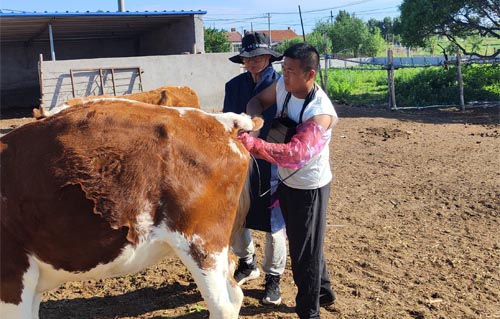
Global Practices and Case Studies
Handheld ultrasound is now common in many countries, often as part of herd management protocols:
United States: Many American ranchers carry portable ultrasound units during breeding and finishing. The Beef Cattle Institute reports that using ultrasound has increased pregnancy detection accuracy by up to 20%, and it improves carcass selection by measuring live muscle and fat profiles. This data-driven approach lets ranchers identify the best replacement heifers or feeding strategies for young bulls.
Germany: In Europe, dairy producers adopt ultrasound post-partum. German dairy farms routinely scan cows during the voluntary waiting period to ensure the uterus has involuted properly before rebreeding. This practice has reduced involuntary culling due to hidden uterine infections, leading to steadier milk production.
Brazil: In tropical livestock systems, veterinarians use handheld ultrasound to overcome heat-stress challenges. They screen cows for delayed ovulation and uterine abnormalities that are common under heat and parasite pressure. Brazilian researchers have even integrated ultrasound imaging into synchronization programs to monitor follicle development, optimizing timing for artificial insemination.
Australia: Besides sheep and goats (as mentioned above), Australian and New Zealand beef producers also rely on ultrasound for body condition scoring. Measuring backfat and eye muscle helps them manage finishing rations in high-performance feeding systems, as noted in New Zealand practices.
Developing Regions: In low-resource settings, the affordability and portability of handheld ultrasound make it a valuable tool for community animal health workers. For example, in parts of Africa and Asia, vets use portable scanners for cattle pregnancy checks and to diagnose common conditions (such as pericardial effusion in cows) without needing electricity or large clinics. This democratization of imaging has been accelerated worldwide by improved battery tech and smartphone integration.
These global examples underline that handheld ultrasound isn’t just a high-tech novelty—it’s becoming a standard part of on-farm diagnostics. Training programs and mobile apps have grown to teach farmers and technicians how to interpret scans, reflecting the technology’s broad acceptance.
Practical Benefits on the Farm
Putting all this into practice yields clear benefits:
Increased Fertility and Productivity: Early pregnancy checks and reproductive monitoring improve herd fertility cycles. Detecting empty cows or sows quickly allows prompt rebreeding. Farms using regular ultrasound report higher conception rates and more predictable calving/lambing schedules.
Animal Welfare Improvements: Early, accurate diagnosis of ailments means animals receive treatment sooner. Handheld ultrasound helps identify issues like uterine infections, ovarian cysts, or even internal abscesses without invasive surgery. Reducing animal suffering and avoiding unnecessary culling is a major welfare gain.
Lower Veterinary Costs: Although the initial investment in a scanner and training is non-trivial, farms often recover costs by needing fewer external vet visits. As one source notes, many operations see a 10–20% drop in reproductive failure after adopting routine ultrasound monitoring, which can save thousands in lost calves or litters.
Data-Driven Feeding: As illustrated earlier, knowing precise body measurements lets nutritionists formulate diets more efficiently. Farms that integrate ultrasound data into feeding decisions report significant savings (e.g. ~15% less feed in pigs) and more uniform growth across the herd.
Faster Informed Decisions: Real-time imaging enables rapid action during breeding programs. For instance, embryologists use ultrasounds to select donor and recipient cows during IVF work, and large animal vets perform field surgeries (e.g. fluid taps) with ultrasound guidance. This immediacy makes interventions more precise.
In summary, handheld ultrasound equips farmers and vets with a powerful decision-making tool. The accumulated effect is healthier herds, improved production efficiency, and better quality of animal products.
Challenges and Training
Despite its advantages, on-site ultrasound comes with considerations:
Operator Skill: Interpreting ultrasound images requires training and practice. A novice may misread a scan, leading to wrong decisions (e.g. misdiagnosing pregnancy). Consequently, successful programs include training courses, guided tutorials, or remote tele-mentoring. Many companies now offer simulation apps and online modules to help new users reach proficiency.
Device Selection: Not all scanners are the same. Farms must choose units with the right probes and durability for their species and environment. For example, dairy operations scanning hundreds of cows might prioritize a long battery life and quick probe changeover, whereas a mixed-species farm may favor an all-in-one wireless probe. Budget is also a factor, though the range of prices has expanded in recent years.
Data Management: Collecting images is one thing; managing the data is another. To fully leverage ultrasound, farms need software or records systems to archive and analyze scans. This often means adopting herd management software that can integrate ultrasound findings into animal health records.
Technical Limitations: In very large or obese animals, ultrasound penetration can be limited. Some deep organs may remain difficult to image without specialized probes. Weather can also be a factor – extreme cold or direct sunlight may temporarily affect portable screens or batteries.
Addressing these challenges is an ongoing process. The veterinary community emphasizes that proper training and choosing the right equipment are crucial steps to ensure handheld ultrasound adds value rather than confusion.
Future Trends in Animal Ultrasound
The evolution of handheld ultrasound continues. Emerging trends include:
3D and 4D Imaging: Portable units are starting to offer 3D (volume) scans and even 4D (real-time 3D) imaging in the field. This could enhance fetal visualization or surgical planning.
Continuous Monitoring: Researchers envision wearable ultrasound patches for continuous monitoring of livestock, alerting farmers to health issues as they develop.
Advanced AI Diagnostics: Future devices will likely include more AI analysis – automatically flagging abnormalities or quantifying tissues (fat percentage, lesion size) without human input.
Interconnected Herd Health: Cloud platforms will integrate ultrasound data with genetics and health records, enabling big-data analytics across many farms.
Multispecies Configurations: Manufacturers are developing presets and probes that work across multiple species, making it easier for mixed farms or vet practices to use one scanner for all needs.
Renewable Power Options: Solar or supercap charging for rural or off-grid farms could extend the reach of ultrasound into even more remote areas.
As technology advances, the core benefit remains: bringing high-quality imaging directly to where the animals are. Handheld ultrasound is still in its ascendancy, and its role in everyday veterinary care is expected to grow.
Conclusion
Handheld ultrasound has opened a new chapter in veterinary diagnostics. By making ultrasound portable, affordable, and user-friendly, this technology puts powerful imaging tools into the hands of farmers and clinicians. The result is smarter on-site animal screening – from breeding management to disease detection – guided by real-time visual data. Global experiences show that adopting handheld ultrasound leads to more productive herds and healthier animals. For the livestock industry, the message is clear: investing in on-farm ultrasound pays dividends in animal welfare and farm efficiency. As one expert review notes, the ongoing democratization of POCUS means that “as portable ultrasound systems become more ubiquitous, ... trained users can reach a rapid and reliable diagnosis” at the point of care. Embracing this innovation allows producers worldwide to make timely, data-driven decisions that boost both profitability and animal health.
Reference Sources:
El Kaffas, A., Vo-Phamhi, J.M., Griffin, J.F. IV, & Hoyt, K. (2024). Critical Advances for Democratizing Ultrasound Diagnostics in Human and Veterinary Medicine. Annual Review of Biomedical Engineering, 26, 49–65. [https://pmc.ncbi.nlm.nih.gov/articles/PMC11238906/].
Boxianglai Vet (BXL) (2025). “Boosting Animal Health Through Real-Time Ultrasound Imaging on Farms.” BXL News (June 14, 2025). [https://www.bxlvet.com/news/boosting-animal-health-through-real-time-ultrasound-imaging-on-farms.html].
Boxianglai Vet (BXL) (2025). “Compact Power: The Technology Behind Portable Livestock Ultrasound.” BXL News (April 29, 2025). [https://www.bxlvet.com/de/news/compact-power-the-technology-behind-portable-livestock-ultrasound.html].
Ryan, S. (2024). “Why Every Veterinary Practice Should Have a Portable Handheld Ultrasound Unit.” Obi Veterinary Education (Blog, Oct 22, 2024). [https://obivet.com/veterinary-handheld-ultrasound/].

